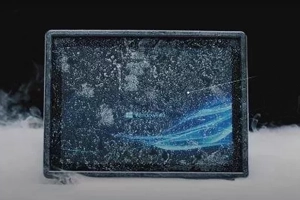
Why Choosing the Right Technology Matters in Cold Storage
In cold storage facilities, efficiency and accuracy are key to maintaining seamless supply chain operations. Whether for order picking, inventory management, maintenance, or quality control, technology plays a crucial role in keeping operations running smoothly. However, not all IT devices are built to withstand the unique challenges of cold environments. Selecting the right technology can mean the difference between operational success and costly disruptions.
The Challenges of Cold Storage Environments
Cold storage environments present a unique set of challenges that impact the performance and durability of electronic devices. Unlike standard warehouse settings, cold storage facilities require equipment that can endure extreme temperature fluctuations, moisture buildup, and restricted connectivity.
- Temperature Extremes and Their Impact on Devices
Most consumer-grade devices are designed to function in temperatures above 32°F (0°C). However, in cold storage, temperatures can drop significantly below freezing. At these temperatures:
- Batteries discharge at a much faster rate, reducing productivity.
- Screens and scanners can frost over, making them unreadable.
- LCD screens slow down, causing delays in data retrieval and entry.
- Condensation and Moisture Buildup
One of the biggest threats to electronic devices in cold storage is condensation. As workers move between cold storage areas and warmer warehouse spaces, the rapid temperature shift causes moisture to accumulate on and inside devices. This can lead to:
- Fogging of screens and scanner windows, reducing visibility.
- Internal component damage due to corrosion or short-circuiting.
- Frozen keypads and buttons, rendering devices unusable.
- Connectivity and Signal Challenges
Cold storage facilities often have thick insulated walls, which weaken radio signals and reduce connectivity range. This can disrupt real-time data communication, leading to inefficiencies and errors in inventory management. - Ergonomic and Usability Issues
Workers in cold storage environments must wear gloves to protect against freezing temperatures. Consumer devices are not designed for gloved operation, making it difficult to use touchscreens, keypads, and scanners efficiently. The result? Increased errors and slower workflows.
Key Considerations for Cold Storage Technology
Selecting the right technology for cold storage requires looking beyond basic specifications like operating temperature. The following factors are critical in ensuring reliability and performance:
- Integrated Heating Elements
Devices with built-in heaters help prevent condensation buildup on screens and scanner windows. These heaters ensure clear visibility and uninterrupted operation, even when moving between temperature zones. - Cold-Specific Batteries
Standard lithium-ion batteries do not perform well in freezing temperatures. Cold-rated or freezer-specific batteries discharge at a slower pace, allowing devices to last longer during shifts without frequent recharging. - High Ingress Protection (IP) Rating
A high IP rating ensures that devices are well-sealed against moisture ingress. Ideally, devices should have at least an IP65 rating, though IP66 or IP67 is even better for environments with extreme condensation risks. - Glove-Compatible Touchscreens and Keypads
Devices designed for cold storage should feature resistive touchscreens or oversized keypads that allow workers to operate them while wearing thick gloves. This improves accuracy and speed in data entry and scanning. - Optimized Connectivity Solutions
Cold storage facilities need reliable wireless communication. External antennas, session-persistence software, and high-gain Wi-Fi solutions help ensure continuous connectivity even in challenging environments. - Durability and Ruggedization
Materials used in device construction must withstand extreme cold. Certain plastics become brittle at freezing temperatures, increasing the risk of damage from drops. Rugged devices with reinforced casings and impact-resistant materials are essential for durability. - Peripheral and Accessory Considerations
In addition to mobile computers, accessories like barcode scanners, printers, and headsets must also be cold-rated. Heated keyboards and freezer-rated cables prevent operational slowdowns caused by ice accumulation.
Maximizing Productivity in Cold Storage Operations
To maintain high efficiency in cold storage environments, businesses should:
- Invest in purpose-built technology that is specifically designed for extreme cold conditions.
- Train workers on how to handle and maintain their devices properly to extend their lifespan.
- Implement connectivity solutions that ensure real-time data access despite environmental challenges.
- Regularly inspect and maintain equipment to prevent unexpected failures and costly downtime.
Both our standard JLT6012 and JLT1214P computers have a glass touchscreen that can be used with gloves and is easy to wipe off and keep clean from ice and moisture. The temperature spec even guarantees full functionality all the way down to minus 30°C.
For better connectivity, external antennas can be added or, if connection inside the cold storage is lost or unavailable, third-party solutions that allow for session persistence can be installed. That way, data can be entered and stored without a connection, and then updated as soon as the device regains signal.
Final Thoughts
The unique challenges of cold storage environments demand specialized solutions. Companies must go beyond standard spec sheets and carefully evaluate the real-world performance of their technology investments. By choosing rugged, cold-rated IT solutions from JLT mobile computers with the right features—such as heated screens, specialized batteries, and durable materials—businesses can ensure efficiency, accuracy, and uninterrupted workflow in even the harshest conditions.
Investing in the right technology today means fewer operational headaches and greater long-term success in the cold chain industry. Want to learn more about how your business can optimize its cold storage operations? Reach out to industry experts for tailored solutions that meet your specific needs.
Want to learn more?
We’re here to help and advise you on every aspect of rugged devices and industry data communications.
Please fill in the form and we will get back to you as soon as possible.
